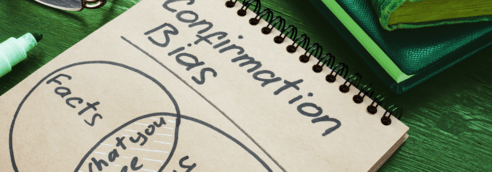The following activities will guide students through exploring how confirmation bias works, when it happens, and most important, how to recognize it in themselves. By developing this self‐awareness, students can become more open to different perspectives and engage in more thoughtful, civil discussions both in and out of the classroom.


Why do we seek and interpret information in ways that favor our existing beliefs?
Objectives
-
Explain the bias.
-
Provide examples of the bias in practice.
-
Construct strategies for overcoming and dealing with the bias.
Materials Needed
-
Mental Notes graphic organizers for students
Bias Description
Confirmation bias is a phenomenon in which people seek or interpret information in ways that are favorable to their preexisting beliefs. Conversely, they discount or avoid information that is contradictory. This thinking pattern may be conscious or subconscious and may result in hypothesis myopia.
Pros and Cons of the Bias
Pros
- Can elicit feelings of confidence and intelligence
Cons
-
Can lead to poor decision‐making by deprioritizing or not acknowledging information that does not confirm beliefs
-
Can exacerbate social exclusion and tensions by reinforcing us‐versus‐them, in‐group bias
-
Can support groupthink and bandwagon effect biases
Real‐World Examples of the Bias
-
A sports fan believes their team is the best and only notices the positive calls made by referees, while ignoring the negative calls that go against their team.
-
A person who believes in a particular horoscope sees events in their life as proof of its accuracy while ignoring contradictory evidence.
Learning Activities
Open
- Have students write the name of the day’s bias and the driving question on their Mental Notes graphic organizer.
Activate
-
Play “The Most Common Cognitive Bias” video.
-
Stop the video at 1:10 and ask students if they can guess the rule. Ask them to explain their thinking. Then play the video to the end.
Ask
-
What did you notice about the number sets you presented when you tried to guess the rule?
-
What strategies did you use to determine the rule?
-
What was preventing you from figuring out the rule sooner?
-
Why do people have trouble guessing the rule?
Explain
-
Describe confirmation bias to students.
-
Explain that it occurs because our brains rely on cognitive shortcuts to make decisions more efficiently and minimize discomfort from cognitive dissonance, often choosing the path of least resistance. We experience positive feelings when we’re right and discomfort when we’re wrong, which reinforces and confirms our original thinking. This tendency can lead to groupthink, strengthening social bonding within groups. Additionally, our past knowledge shapes how we interpret new information and form judgments.
-
Confirmation bias can be avoided by actively seeking neutral sources of information, seeking evidence and ideas that are different (e.g., reading about or listening to people who differ from you in their opinions), and engaging in discussions with those who disagree or can ask challenging questions.
-
Discuss
-
Divide students into groups and have them discuss the following questions:
-
In what situations can confirmation bias be helpful? Harmful?
-
When have you seen this bias in action?
-
When are people most susceptible to this bias?
-
How can people recognize when they are being affected by this bias?
-
What are some ways to overcome and deal with this bias?
-
What is the relationship between this bias and humility? In what ways can our awareness of this bias improve our relationships with others?
-
Synthesize and Close
Ask each group to share what they discussed for at least 1 of the questions. Revisit the driving question and make sure students have responded to the driving question in their Mental Notes for the day.